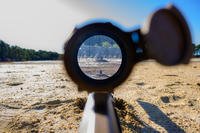MILWAUKEE - Officially, Sgt. Sean Huolihan's job with Battery B, 1st Battalion, 121st Field Artillery during the unit's Afghanistan deployment was communications section chief.
On the side, he tried to capture the history of a historic deployment — the first Army National Guard combat field artillery mission in Afghanistan — one frame at a time.
Not an easy task when your missions are classified.
"The whole 'no cameras allowed' rule, you know," Huolihan explained.
Still, many of the images he did capture are breathtaking — sprawling landscapes made profound by the intensity of color, High Mobility Artillery Rocket System (HIMARS) launchers belching fire and rockets with remarkable clarity.
"I had never photographed anything remotely like this," the self-taught photographer admitted. "It has been challenging, from keeping my equipment clean and secure to really pushing the equipment to its limitations without using flash.
"I guess I started the process knowing I wanted to make the battery look as good as everyone said we are," he continued. "We're the best battery and chosen for a once-a-lifetime experience, and I hoped to portray that experience to the world."
First Sgt. Steven Czekala said Huolihan's photos meant a great deal to Battery B.
"His skills as a photographer are second to none, and showed the battery in a light that no one else could," Czekala said. "Because of security issues, his work is all anybody has to remember our tour of duty.
"He did outstanding work documenting what he could to tell the unit's story," Czekala said. "As soldiers, we are excellent at what we do, but terrible at recording history."
Czekala noted that Huolihan did not focus on photography at the expense of the mission.
"It goes without saying that communication is one of the three needs in order to win on the battlefield," he said. "Our mission was not of the usual nature, and if we could not communicate, there could be serious consequences. We had no serious communication issues, and we never failed to meet a mission, due in large part to our ability to communicate. Sgt. Huolihan should receive credit for that."
Huolihan - a resident of Shorewood, Wis. - devoted much of his free time studying the business side of photography, learning new techniques and refining his photo processing skills. An electrical transformer inspector by trade, he wants to start his own photography business. He usually has a camera on him at all times.
"People think that photography is just clicking a button, but for me that's only the beginning," he explained. "Shooting in raw format" (an unprocessed digital image that usually has a broader dynamic range or color range than a jpeg file) "requires a great deal of post-processing to get a lot of the outcome I desire. It feels great when you're looking at the screen and the editing is done, and you know that you're delivering an absolutely awesome photo."
Huolihan was reluctant to single out any photo or series of photos as his favorites, but Czekala recalled a time-lapse photo of a HIMARS launcher with the stars moving in a circular formation in the night sky.
"He was always willing to do what we requested, and that usually happened in the middle of what would have been his sleep cycle," Czekala said. "I am very glad he did what he did, so our work can be remembered for generations to come."
Capt. Matthew Mangerson, Battery B commander, said it was clear that Huolihan had a passion for photography.
"Obviously it is much easier to be tasked with something you enjoy," Mangerson said. "However, he took that dedication and availability to another level. He could be asked to facilitate any unit historian or photography project at a moment's notice, at any time of the day."
Mangerson noted that Huolihan's photos, in addition to being compiled online, have been used to support an upcoming article in Fires Journal — a field artillery publication — as well as a unit submission packet for the Alexander Hamilton Award, which recognizes the best Army National Guard field artillery unit.
"Any organization that heavily utilizes photography and public media would be lucky to have Sgt. Huolihan," Mangerson said.
The photographer, who recently signed up for another six-year term of service, was content to let his photos speak for themselves.
"Basically, I documented things as they happened," Huolihan explained. "I just took it upon myself to take pretty pictures."























